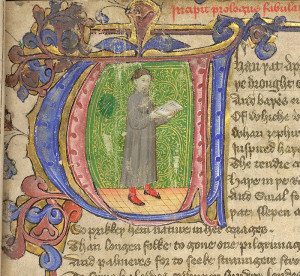(Landsdowne MS 851 f. 2r)
For those of you who follow me on Twitter, you may have noticed my tweets over the last month or so under the hashtag #100_tc. I just finished tweeting Chaucer’s Troilus and Criseyde in 100 tweets. It all started with Elaine Treharne dividing Beowulf in 101 tweets over a year ago. Then recently Eric Weiskott took to Gawain in 101 tweets. I was immediately fascinated with this kind of reconceptualization of the stories, and got very excited, wanting to participate. I mulled over which text would be best suited for this kind of division, and simultaneously wanted to challenge myself – how far could I go with this?
While I have taught Chaucer before, this Fall will be my first time teaching Troilus and Criseyde, so I have been experimenting with form and style of delivery to make it as accessible as possible to first and second year students, especially those who are not going to be English majors, or even in the humanities. To me it seemed obvious this text would be the perfect candidate for my Twitter project. I want my students to digest this (perhaps intimidating) narrative, and thus I began tearing up the text, creating small palpable pieces that could be reassembled once individually understood.
I have to say I learned an incredible amount from this experiment. The five books of the Troilus comprise 1178 stanzas, meaning that in order to tweet the whole work in 100 tweets I was left to consolidate anywhere between 10-14 stanzas per tweet. 10-14 stanzas of an incredibly complex and rich text in 140 characters(!). I was very quickly reacquainted with the art of brevity, concerning myself with every single letter – abbreviating all names to a single letter, becoming creative with my use of symbols, and even sometimes changing tense to avoid an “ed” ending, among other small tricks employed – all the while maintaining coherency.
Further, before creating even a handful of tweets I noticed how often I would have to take on the role of editor and constantly ask myself “what is important? what do I want to share?” with the understanding that much would also be elided in the process. This is when I realized there were multiple narratives at play, and my most important points were not necessarily everyone else’s. In other words, should someone else engage in this same activity their tweets would not mirror mine but rather occasionally cross paths as they found their own points of interest to focus on and incorporate in their narrative.
In short, while recreating the story, as I asked myself, and will soon ask my students “what is Troilus and Criseyde about?” it has become evident that there far more answers than I had previously taken into account. This has been an extremely eye-opening exercise, and one which I would most definitely recommend to others.
Here is the Storified version of my tweets, all 100 of them, from beginning to end.






